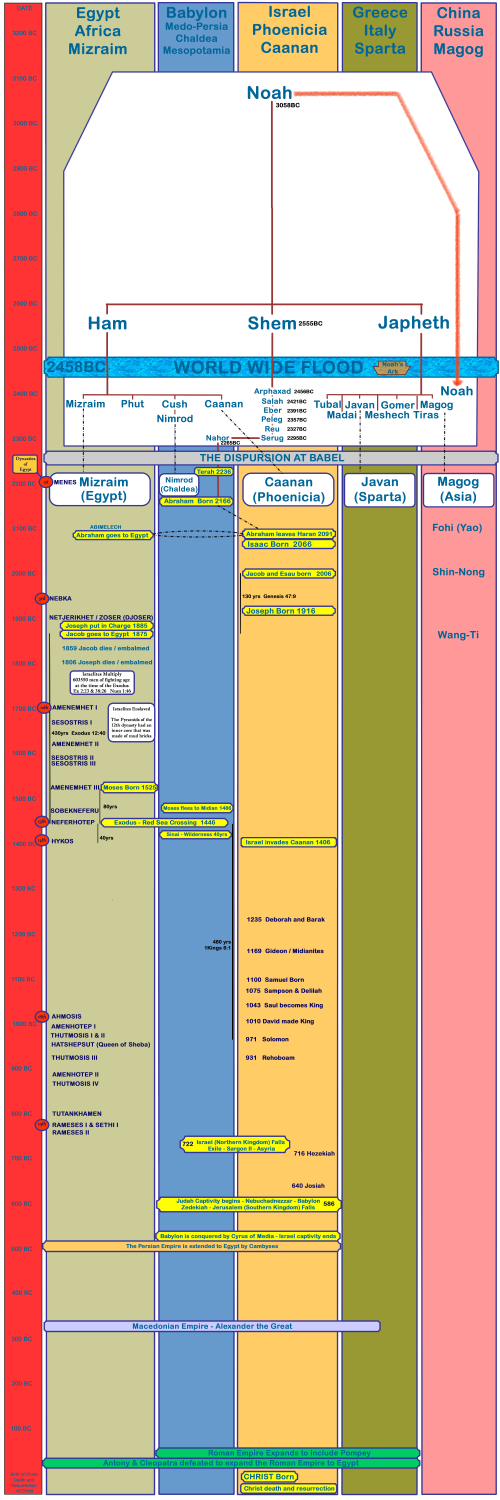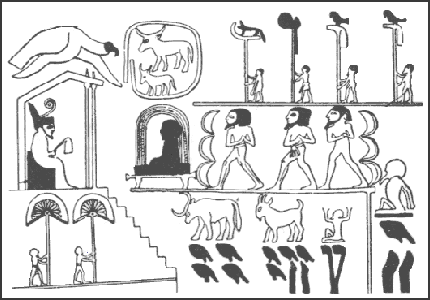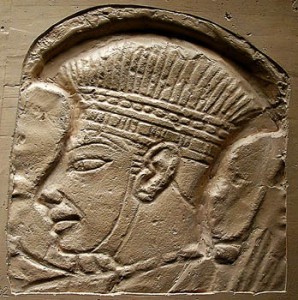Taken from: http://thepharaohofabraham.wordpress.com/tag/mizraim/
Contemporaries in Egypt and Israel and estimated dates
August 27, 2011
Mizraim = Menes12th dynasty, 13th dynasty, 15th dynasty, 18th dynasty, 3rd dynasty, 400 years, Abimalech, Abimelech, Abraham, Amenemhet III, Amenhotep I, bible, Chronology, comtemporaries, core, David Down, Djoser, drnhawkins, first dynasty, hatshepsut, hyksos, imhotep, israel, Israelite, Jereboam, Joseph, Joshua, King, Manetho, Menes, Mizraim, moses, mud bricks, Narmer, Neferhotep, Netjerikhet, Pharaoh, Pyramid, Queen of Sheba, Red sea crossing, Saul, slaves, Third dynasty, Thutmosis I, Thutmosis III, ZozerLeave a comment
Date Egypt Israel
2320BC Menes (Mizraim) (1st Dynasty)
2080BC Abimelech (First Dynasty) Abraham
1900BC Djoser (Third Dynasty) Joseph ( Imhotep)
1531BC Amenemhet III (12th Dyn) Moses – Israel slaves
1445BC Neferhotep I (13th Dynasty) Moses (The Exodus)
1405BC Hyksos (15th & 16th Dynasty) Joshua to Saul
1018BC Amenhotep I & Thutmosis I (18th Dyn) King David
950BC Hatshepsut [Queen of Sheba] (18th Dyn) Solomon
929BC Thutmosis III (18th Dynasty) Jereboam
- http://www.answersingenesis.org/creation/v26/i4/pyramids.asp
- http://josephandisraelinegypt.wordpress.com/feature-article-imhotep-and-joseph-are-the-same-person/
- http://www.answersingenesis.org/articles/nab2/doesnt-egyptian-chronology-prove-bible-unreliable
- http://home.comcast.net/~r.engle/pafg20.htm#911
- http://en.wikipedia.org/wiki/Mizraim
- http://www.ulcmn.org/Files/Studies/Bible%20Timeline%20Septuagint.pdf
- http://www.ccg.org/english/s/p045c.html
Mizraim identified with Menes (even by Manetho)
August 26, 2011
http://www.kneelingmedia.org/Clarity-EgyptSyncBible.pdf
http://home.comcast.net/~r.engle/pafg20.htm#911
http://en.wikipedia.org/wiki/Mizraim
http://www.ulcmn.org/Files/Studies/Bible%20Timeline%20Septuagint.pdf
http://www.ccg.org/english/s/p045c.html
http://creation.com/egyptian-history-and-the-biblical-record-a-perfect-match
http://home.comcast.net/~r.engle/pafg20.htm#911
http://en.wikipedia.org/wiki/Mizraim
http://www.ulcmn.org/Files/Studies/Bible%20Timeline%20Septuagint.pdf
http://www.ccg.org/english/s/p045c.html
http://creation.com/egyptian-history-and-the-biblical-record-a-perfect-match
Abram’s “Pharaoh” Biblically Named and archaeologically identified
August 23, 2011
UncategorizedAbraham, Abram, amaic, Amiram, Arad, archaeology, bible, dynasty 0, dynasty 1, early bronze, early bronze age, Egypt, first dynasty, Genesis, Gerzean period, Ghassul IV, Isaac, Ishmael, Jordan Valley, Late Chalcolithic period, Lechabim, Lehabim, Mizraim, Narmer, Osgood, Palestine, Pharaoh, pre-dynastic Egypt, Sarah, Sarai, sherd, Southern, Stratum IV, Stratum VLeave a comment
http://houseofgold.blog.com/tag/abram-abraham-sarah-sarai-abimelech-pharaoh-narmer/
Below is an exerpt from the above link – a blog on ”House of Gold” posted by ‘Amaic’
Below is an exerpt from the above link – a blog on ”House of Gold” posted by ‘Amaic’
…….we might be surprised to learn that so great a Patriarch as Abram (later
Abraham), did not sign off the record of his own history (as did e.g. Adam,
Noah, and Jacob). No, Abram’s story was recorded instead by his two chief sons,
Ishmael and Isaac.
Abraham), did not sign off the record of his own history (as did e.g. Adam,
Noah, and Jacob). No, Abram’s story was recorded instead by his two chief sons,
Ishmael and Isaac.
“These are the generations of Ishmael …” (Genesis
25:12).
25:12).
“These are the generations of Isaac …” (Genesis
25:19).
25:19).
So, there were two hands at work in this particular narrative, and
this fact explains the otherwise strange repetition of several famous incidents
recorded in the narrative.
this fact explains the otherwise strange repetition of several famous incidents
recorded in the narrative.
And it is in the second telling of the incident of the abduction of
Abram’s wife, Sarai (later Sarah), that we get the name of the ruler who, in the
first telling of it is called simply “Pharaoh”. He is “Abimelech”
(20:2).
Abram’s wife, Sarai (later Sarah), that we get the name of the ruler who, in the
first telling of it is called simply “Pharaoh”. He is “Abimelech”
(20:2).
Admittedly, there are such seeming differences between the two accounts, as
regards names, geography and chronology, as perhaps to discourage one from
considering them to be referring to the very same incident; and that despite
such obvious similarities as:
regards names, geography and chronology, as perhaps to discourage one from
considering them to be referring to the very same incident; and that despite
such obvious similarities as:
- the Patriarch claiming that his beautiful wife was his
“sister”;
“sister”;
- the ruler of the land taking her for his own;
- he then discovering that she was already married (underlined by
plagues);
plagues);
- and asking the Patriarch why he had deceived him by saying that the
woman was his sister;
woman was his sister;
- the return of the woman to her husband, whose possessions are now
augmented.
augmented.
The seeming contradictions between the two accounts are that, whereas the
first incident occurs in Egypt, and the covetous ruler is a “Pharaoh”, the
second seems to be located in southern Palestine, with the ruler being “King
Abimelech of Gerar”, and who (according to a somewhat similar incident again
after Isaac had married) was “King Abimelech of the Philistines” (26:1). Again,
in the first account, the Patriarch and his wife have their old names, Abram and
Sarai, whereas in the second account they are referred to as Abraham and Sarah,
presumably indicating a later time. In the first account, the “Pharaoh” is
“afflicted with great plagues because of Sarai”, whereas, in the second, “God
healed Abimelech, and also healed his wife and female slaves so that they bore
children” (20:17).
first incident occurs in Egypt, and the covetous ruler is a “Pharaoh”, the
second seems to be located in southern Palestine, with the ruler being “King
Abimelech of Gerar”, and who (according to a somewhat similar incident again
after Isaac had married) was “King Abimelech of the Philistines” (26:1). Again,
in the first account, the Patriarch and his wife have their old names, Abram and
Sarai, whereas in the second account they are referred to as Abraham and Sarah,
presumably indicating a later time. In the first account, the “Pharaoh” is
“afflicted with great plagues because of Sarai”, whereas, in the second, “God
healed Abimelech, and also healed his wife and female slaves so that they bore
children” (20:17).
The differences can be explained fairly easily.
Ishmael understandably wrote his father’s history from an Egyptian
perspective, because his mother, Hagar, was “an Egyptian slave-girl” in
Abram’s household, and she later “got a wife for [Ishmael] from the land of
Egypt” (cf. 16:1 & 21:21). Ishmael names his father “Abram” because
that is how he was known to Ishmael. Moreover, the incident with “Pharaoh” had
occurred while the Patriarch was still called Abram. Isaac was not even born
until some 25 years after this incident. His parents were re-named as Abraham
and Sarah just prior to his birth. So, naturally, Isaac refers to them as such
in the abduction incident, even though they were then Abram and Sarai. Again,
there is no contradiction geographically between Egypt and Gerar because we are
distinctly told in Ishmael’s account that it was just before the family went to
Egypt (12:11) that Abram had told his wife that she was to be known as his
sister. Gerar is on the way to Egypt.
perspective, because his mother, Hagar, was “an Egyptian slave-girl” in
Abram’s household, and she later “got a wife for [Ishmael] from the land of
Egypt” (cf. 16:1 & 21:21). Ishmael names his father “Abram” because
that is how he was known to Ishmael. Moreover, the incident with “Pharaoh” had
occurred while the Patriarch was still called Abram. Isaac was not even born
until some 25 years after this incident. His parents were re-named as Abraham
and Sarah just prior to his birth. So, naturally, Isaac refers to them as such
in the abduction incident, even though they were then Abram and Sarai. Again,
there is no contradiction geographically between Egypt and Gerar because we are
distinctly told in Ishmael’s account that it was just before the family went to
Egypt (12:11) that Abram had told his wife that she was to be known as his
sister. Gerar is on the way to Egypt.
Finally, whether the one whom Isaac calls “Abimelech” was still, in Isaac’s
day, “Pharaoh” of Egypt, as he had been in former times, he was most definitely
at least ruler over the Philistines at Gerar. Perhaps he ruled both lands, Egypt
and Philistia. Be that as it may, the Holy Spirit has apparently
provided the name of Abram’s “Pharaoh”. But one needs to respect His literary
structures to discover that name. We now know his personal name:
“Abimelech”.
day, “Pharaoh” of Egypt, as he had been in former times, he was most definitely
at least ruler over the Philistines at Gerar. Perhaps he ruled both lands, Egypt
and Philistia. Be that as it may, the Holy Spirit has apparently
provided the name of Abram’s “Pharaoh”. But one needs to respect His literary
structures to discover that name. We now know his personal name:
“Abimelech”.
In Hebrew it means “Father is King”.
Since Abimelech is not an Egyptian name, though (see discussion of this in
2. below), and since the other designation that we have for him
is simply “Pharaoh”, that data, in itself, will not take us the next step of
being able to identify this ruler in the Egyptian historical (or dynastic)
records. But that our Abimelech may have – according to the progression of
Ishmael’s and Isaac’s toledôt histories – ruled Egypt and then gone on
to rule Philistia, could well enable us to locate this ruler archaeologically.
Dr. John Osgood has already done much of the ‘spade work’ for us here,
firstly by nailing the archaeology of En-geddi at the time of Abram (in
the context of Genesis 14) to the Late Chalcolithic period, corresponding to
Ghassul IV in Palestine’s southern Jordan Valley; Stratum V at Arad; and the
Gerzean period in Egypt (“The Times of Abraham”, Ex Nihilo TJ, Vol. 2,
1986, pp. 77-87); and secondly by showing that, immediately following
this period, there was a migration out of Egypt into Philistia, bringing an
entirely new culture (= Early Bronze I, Stratum IV at Arad). P. 86: “In all
likelihood Egypt used northern Sinai as a springboard for forcing her way into
Canaan with the result that all of southern Canaan became an Egyptian domain”.
2. below), and since the other designation that we have for him
is simply “Pharaoh”, that data, in itself, will not take us the next step of
being able to identify this ruler in the Egyptian historical (or dynastic)
records. But that our Abimelech may have – according to the progression of
Ishmael’s and Isaac’s toledôt histories – ruled Egypt and then gone on
to rule Philistia, could well enable us to locate this ruler archaeologically.
Dr. John Osgood has already done much of the ‘spade work’ for us here,
firstly by nailing the archaeology of En-geddi at the time of Abram (in
the context of Genesis 14) to the Late Chalcolithic period, corresponding to
Ghassul IV in Palestine’s southern Jordan Valley; Stratum V at Arad; and the
Gerzean period in Egypt (“The Times of Abraham”, Ex Nihilo TJ, Vol. 2,
1986, pp. 77-87); and secondly by showing that, immediately following
this period, there was a migration out of Egypt into Philistia, bringing an
entirely new culture (= Early Bronze I, Stratum IV at Arad). P. 86: “In all
likelihood Egypt used northern Sinai as a springboard for forcing her way into
Canaan with the result that all of southern Canaan became an Egyptian domain”.
This new phase would seem to correspond very nicely with the time of Narmer,
since, at this very archaeological phase, according to Osgood (ibid.,p. 85): “Belonging to Stratum IV [at Arad] Amiram found a sherd with
the name of Narmer …”. Now Narmer was either the first pharaoh of Egypt’s
First Dynasty or the last pre-dynastic ruler of what is sometimes known as
Dynasty 0 (or perhaps he was both)……..
since, at this very archaeological phase, according to Osgood (ibid.,p. 85): “Belonging to Stratum IV [at Arad] Amiram found a sherd with
the name of Narmer …”. Now Narmer was either the first pharaoh of Egypt’s
First Dynasty or the last pre-dynastic ruler of what is sometimes known as
Dynasty 0 (or perhaps he was both)……..
………a further tentative suggestion that I have made that Abimelech might even have
been the same as Lehabim (i.e. abim-e-leh), the third son of Mizraïm (or Egypt)
(Genesis 10:13)…..
been the same as Lehabim (i.e. abim-e-leh), the third son of Mizraïm (or Egypt)
(Genesis 10:13)…..
The above is an exerpt from the following site:
Facinating……… and it has a ‘ring’ of truth to it ……..well done! …… DrnhawkinsWas Abimelech Lehabim son of Mizraim?
August 22, 2011
UncategorizedAbimelech, Abraham, amaic, contemporary, Egypt, Lehabim, Mizraim, Pharaoh, sonLeave a comment
Genesis 10:6-14
The sons of Ham were Cush and Mizraim and Put and Canaan. The sons of Cush were Seba and Havilah and Sabtah and Raamah and Sabteca; and the sons of Raamah were Sheba and Dedan. Now Cush became the father of Nimrod; he became a mighty one on the earth. He was a mighty hunter before the LORD; therefore it is said, “Like Nimrod a mighty hunter before the LORD.” The beginning of his kingdom was Babel and Erech and Accad and Calneh, in the land of Shinar. From that land he went forth into Assyria, and built Nineveh and Rehoboth-Ir and Calah, and Resen between Nineveh and Calah; that is the great city. Mizraim became the father of Ludim and Anamim and Lehabim and Naphtuhim and Pathrusim and Casluhim (from which came the Philistines) and Caphtorim.
….
….
Would not the King Abimelech, contemporary of Abram, be Lehabim (= Abim-lech), son of Mizraim?




No comments:
Post a Comment